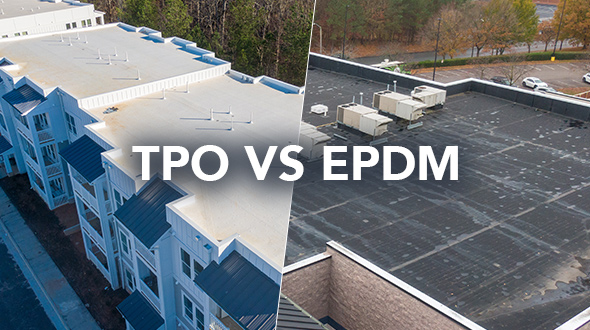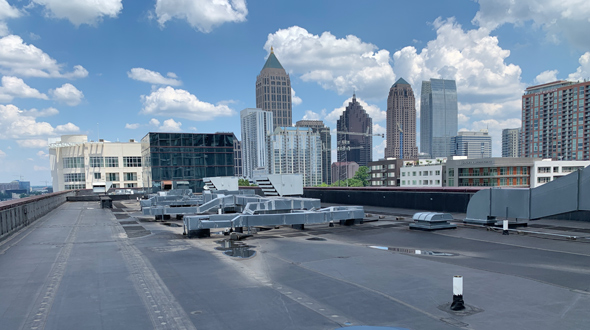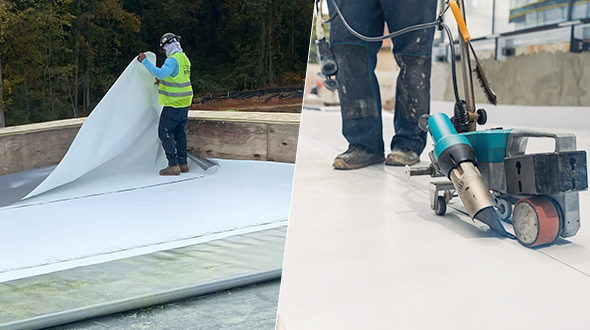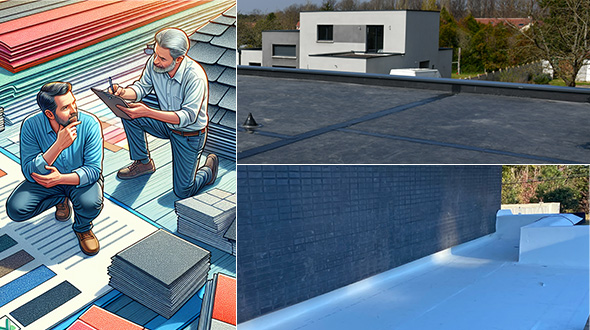Deciding between TPO vs EPDM roofing? We’ll compare their costs, durability, and energy efficiency to help you make the right choice for your building.

Key Takeaways
- TPO roofing offers superior energy efficiency and is lightweight, featuring hot-air welded seams for enhanced durability, puncture, and leak protection.
- EPDM roofing is more cost-effective in the long run due to its longevity, typically lasting over 30 years with proper maintenance.
- Both TPO and EPDM are environmentally friendly options, with TPO being fully recyclable and having lower chemical emissions, while EPDM also boasts good insulating properties.
Understanding TPO and EPDM Roofing Systems
TPO stands for Thermoplastic Polyolefin. It is a single-ply reflective membrane commonly used in flat-top and semi-flat commercial buildings. It comprises a single layer of synthetics and a reinforced scrim, making it lightweight and easy to install. TPO roofing is known for its energy-efficient properties and substantially reduced cooling costs. The TPO membrane is a popular choice for many roofing applications.
EPDM roofing, short for Ethylene Propylene Diene Monomer, is a synthetic rubber roof membrane celebrated for its flexibility and economical nature. The EPDM roofing membrane, composed of ethylene, propylene, and carbon black, is renowned for its resistance to heat aging, ozone, and hail, making it a reliable option for various weather conditions.
Designed for low-slope roofs, both TPO and EPDM are ideal for many commercial buildings. With years of satisfactory performance, ease of installation, and economical aspects, these roofing materials have become staples in the roofing industry.
Advantages of EPDM Roofing Systems
Cost-effectiveness makes EPDM roofing systems a practical choice for budget-conscious projects. Despite the lower initial investment, EPDM roofs offer remarkable longevity, often exceeding 30 years with proper maintenance. This long lifespan translates into significant cost savings over time, as fewer replacements and repairs are needed.

Energy efficiency is another significant advantage of EPDM roofing membranes. These roofs help reduce heating and cooling expenses due to their excellent insulating properties, which contribute to overall energy efficiency. EPDM roofing systems offer versatile installation options, enabling customized applications to fit specific project needs.
Advantages of TPO Roofing Systems
TPO roofing systems stand out for their reflective properties, making them an ideal choice for energy-efficient commercial applications. The lighter color of TPO roofs reflects UV light, reducing cooling costs and enhancing energy efficiency. This makes TPO an attractive option for businesses looking to lower their energy bills.
Besides being energy-efficient, TPO roofing is lightweight and available in wide sheets, simplifying installation. TPO membranes are highly resistant to ozone and UV exposure compared to other materials, enhancing their longevity and performance. The seams of TPO roofing are hot-air welded, enhancing leak protection and ensuring durability under various weather conditions when properly installed.
Comparative Analysis: EPDM vs. TPO
When deciding between EPDM and TPO roofing systems, several factors come into play, including cost, longevity, durability, and energy efficiency.
Let’s break down these aspects to provide a clearer comparison.
Cost Comparison
Cost often plays a primary role in choosing a roofing system. EPDM tends to be less expensive than TPO in terms of initial installation costs. The cost of EPDM roofing is approximately $8-$22 per square foot, making it compelling to budget projects and a cost-effective option for many projects.
TPO costs range between $10-$30 per square foot, and its’ reflective properties can lower long-term energy costs by reducing cooling expenses.
While EPDM may have a higher upfront cost, its long lifespan and minimal maintenance requirements make it an economical choice in the long run. Considering initial costs, maintenance requirements, and long-term energy savings are the critical factors when comparing these roofing systems.
Longevity and Durability
Selecting a roofing system requires considering longevity and durability. EPDM roofs exposed to limited impact generally last longer than TPO roofs – often exceeding 30 years with proper maintenance. This longevity makes EPDM a reliable choice at their price point. Susceptibility to leaks at its seams is the one drawback of EPDM. Lastly, EPDM is known for its resistance to environmental stressors such as freezing temperatures, hail, and UV radiation, which enhances its durability appeal.
TPO roofing systems, on the other hand, have an estimated lifespan ranging from 20 to 30 years. TPO roofs provide greater puncture resistance than EPDM, offering up to three times the puncture resistance. TPO shines in the durability department, which makes it ideal for high-traffic and rugged environments. However, as TPO ages, it can lose flexibility and become prone to cracking, which can decrease its durability over time.
Energy Efficiency
Energy efficiency is another critical consideration. TPO’s reflective white surface helps reduce cooling costs by reflecting solar energy, making it an energy-efficient choice for flat and semi-flat commercial buildings. This heat-reflective property is especially beneficial in warmer climates, where reducing cooling costs is a priority.
While not as reflective as TPO, EPDM still offers excellent insulating properties, which can help reduce heating costs in colder climates. When choosing between EPDM and TPO, consider the specific energy efficiency needs of your building and the climate in which it is located.
Installation Considerations
Proper installation significantly affects the performance and longevity of both EPDM and TPO roofing systems. Three methods can be used to install EPDM roofing: fully adhered, mechanically attached, and ballasted. This flexibility enables customized installations tailored to the project’s specific needs.
TPO roofing can be installed mechanically attached or fully adhered, with heat welding used to join the seams. TPO’s thermoplastic material facilitates easy heat welding and pliable working, making it ideal for quick and efficient installation projects.

EPDM is lightweight, negating the need for extra support, and can be quickly and easily installed without requiring an electrical source. Hiring an experienced commercial roofing contractor ensures proper installation and warranty coverage for both EPDM and TPO roofing systems.
Maintenance and Repair
Maintenance and repair play essential roles in any roofing system. EPDM roofing systems have low maintenance needs, requiring infrequent inspections and repairs. However, a primary weakness of EPDM roofing systems is their susceptibility to leaks at seams, which can require attentive maintenance.
TPO roofing systems resist mildew and algae growth, reducing maintenance efforts. TPO is very puncture-resistant, but seams improperly welded can be an issue. Routine inspections and timely repairs ensure long-term performance and durability for both types.
Environmental Impact
Environmental considerations are gaining importance in the roofing industry. TPO roofing is entirely recyclable, bolstering its environmentally friendly reputation. It does not contain chlorine, making it a safer choice for the environment, and tends to emit fewer chemicals compared to other materials such as PVC.
EPDM roofing is also fully recyclable, ensuring the material can be repurposed rather than ending up in landfills. Both TPO and EPDM offer environmentally friendly options, but TPO’s lower chemical emissions give it a slight edge in this regard.
Choosing the Right Roofing System for Your Project
Selecting the right roofing system for your project involves considering factors like climate, budget, and building design. Geographic location, building usage, and external factors such as solar panel installation can also influence the decision between EPDM and TPO roofing systems.

For flat-top buildings, consider the type of material, warranty, and financial cost. Selecting the right roofing system for flat roofs will ensure long-term performance and your ultimate satisfaction.
TPO vs EPDM Summary
In summary, both EPDM and TPO roofing systems offer unique benefits. EPDM is known for its cost-effectiveness, longevity, and versatility, making it a solid choice for budget-conscious projects. TPO stands out for its energy efficiency, puncture resistance, ease of installation, and environmental benefits.
Choosing between EPDM and TPO ultimately depends on your specific project needs, including climate, budget, and building design. By understanding each roofing system’s key differences and benefits, you can make an informed decision that will serve your building well for years to come.
TPO vs EPDM Frequently Asked Questions
What are the main differences between TPO and EPDM roofing systems?
The main differences between TPO and EPDM roofing systems lie in their properties: TPO offers superior energy efficiency and reflective capability, whereas EPDM is valued for its combined durability and cost-effectiveness. Additionally, TPO installation is generally easier and provides enhanced puncture resistance.
Which roofing system is more cost-effective in the long run?
EPDM roofing is more cost-effective in the long run because of its longer lifespan and low maintenance needs, making it a smart investment despite a higher initial expense.
How does the installation process differ between TPO and EPDM?
The installation process for TPO involves mechanical fasteners and heat welding, whereas EPDM can be installed using fully adhered, mechanically attached, or ballasted methods. This difference in installation techniques allows for varying flexibility depending on project needs.
Are both TPO and EPDM roofing systems environmentally friendly?
Both TPO and EPDM roofing systems are environmentally friendly, as they are both recyclable, with TPO also emitting fewer chemicals than PVC. This makes them suitable choices for sustainable roofing solutions.
What factors should I consider when choosing between TPO and EPDM for my building?
When choosing between TPO and EPDM for your building, consider your local climate, budget constraints, design preferences, energy efficiency requirements, and long-term maintenance needs. It’s crucial also to evaluate the environmental impact of each option.
(404) 220-9288
The post TPO vs EPDM Roofing appeared first on atlantacommercialroofingcontractors.com

No comments:
Post a Comment
Note: Only a member of this blog may post a comment.